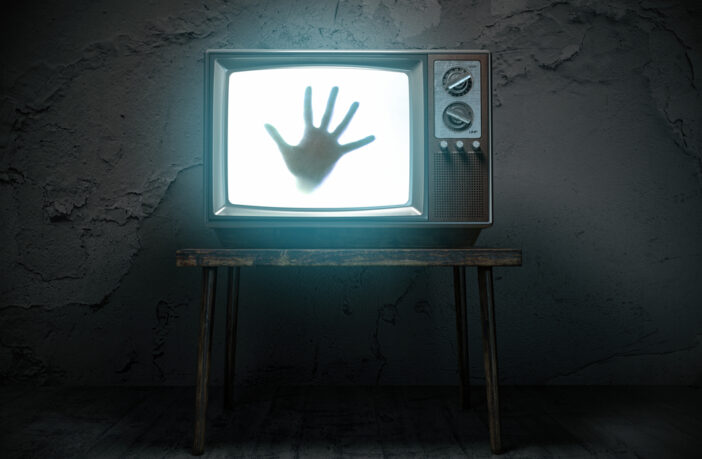As the nights draw in and the spooky season is here, many of us turn to scary stories on screen to indulge in a little bit of supernatural fright so we asked Dr Mark Fryers, lecturer in Film and Media at The Open University for his top spooky film recommendations.
Once derided as infantile at best, or downright dangerous at worst, Mark says that the modern horror movie genre is increasingly being recognised as a fertile arena to explore societal fears, contemporary anxieties, or subjects otherwise considered taboo.
His conclusion is that watching horror films could help with emotional regulation and provide safe spaces to exercise our fight or flight instincts and explore our deepest, darkest fears.
And he points to research from 2021 that suggests horror movies can “function as inoculation against the stresses and terrors of the world”.
The researchers said that intentionally scaring yourself through the horror genre can emulate exposure therapy and prove beneficial, even comforting, to those with anxiety disorders. So here are Mark’s recommendations:
Grief – The Babadook (2014)
On the face of it, The Babadook is a terrifying story about a monster conjured from childhood fear, but Australian writer-director Jennifer Kent’s film is more complicated than that.
Monstrosity becomes a metaphor for our darkest thoughts and fears, particularly following the death of someone close, which are explored through the relationship between a widowed mother and her young son as they face life without a husband and father, alongside more inexplicable events.
Unlike the Victorian era, for example, when grieving mechanisms and practices for bereavement were much more visible and open, grief remains something of a societal taboo.
The Babadook is part of a number of recent horror films that deal openly and directly with sickness, grief and loss such as Mike Flanagan’s Before I Wake or the more extreme films of Ari Aster – Hereditary and Midsommar. The Babadook is available on BBC iPlayer.
Race – Get Out (2017)
Jordan Peele’s Get Out took film-goers by surprise when it was released in 2017. Not only is it full of memorable images, from lead actor Daniel Kaluuya’s expressive eyes to his descent into ‘the sunken place,’ the film itself was a smart, witty but terrifyingly believable satire on contemporary race relations.
Exemplifying the view that there are two Americas – one for middle-class white people, and one for Black citizens – Peele’s film takes this dictum to the logical and horrifying extreme.
More recent films have also used the horror genre to offer a sympathetic and nuanced examination of race and immigration, such as the recent His House (2020), seen through the eyes of two refugees of the Sudanese conflict and their experience of being ‘othered’ on their arrival in England. Get Out is Available on BBC iPlayer.
Ageing – Relic (2020)
Japanese-Australian director Natalie Erika James’ feature-length debut is an exploration of death, ageing and female relationships through a contemporary horror lens.
The film explores the impact of dementia on three female generations of an Australian family, as supernatural events highlight the general theme of disconnection.
While dementia is often detrimentally linked to conceptions of ‘zombiism’ in a number of recent films (Old People, The Elderly), James’ film is more nuanced and sympathetic.
It supplants the comforting environs of the familial home for one infected by a mysterious mould, and which becomes an unfamiliar and oppressive labyrinth. It becomes an active metaphor for the increasing sense of fear and frustration dementia can have on both the afflicted and their loved ones. Available on BBC iPlayer.
Environmentalism – Cthulhu (2007)
Cthulhu is a film fusing contemporary headlines of climate change with the ‘cosmic horror’ of HP Lovecraft, as well as navigating LGBTQ+ issues, as a young man returns to his insular maritime community to fulfil a strange prophecy.
There is a long history of destructive human activity stirring up dormant monsters from the Leviathan in the horror film, dating back at least to the nuclear mutation films of the 1950s, seen as responding to societal fears of nuclear destruction.
Indeed, the Japanese Gojira (Godzilla, 1954) in which nuclear testing in the Pacific awakens the giant prehistoric beast, directly references the actual incident in which the Japanese fishing vessel the ‘Lucky Dragon’ was caught in the fallout of American ‘H-Bomb’ testing in the Bikini Atoll.
By the 1970s, similar films began to reference the burgeoning environmental movement with tales of polluted nature going awry, such as Doomwatch (1972), Frogs (1972) and Long Weekend (1978). Unsurprisingly, in the age of climate crisis, this has accelerated.
These texts do not simply position nature as ‘horrific’ but tend to favour an anthropogenic view of the world – one in which humanity is forced to consider the impact, or take responsibility for, its actions.
Picture: Shutterstock



